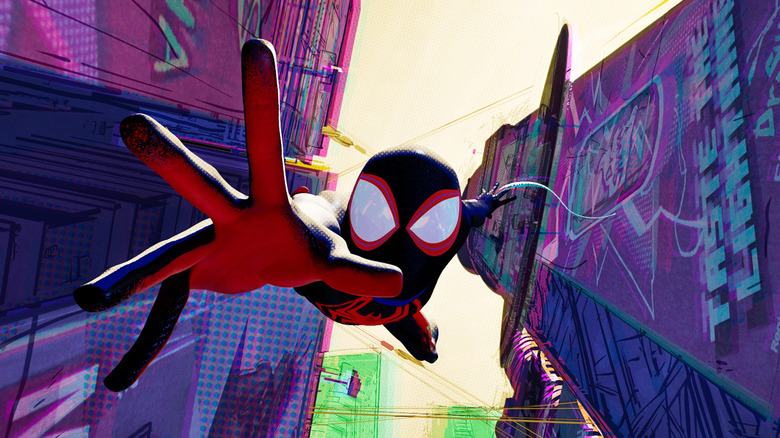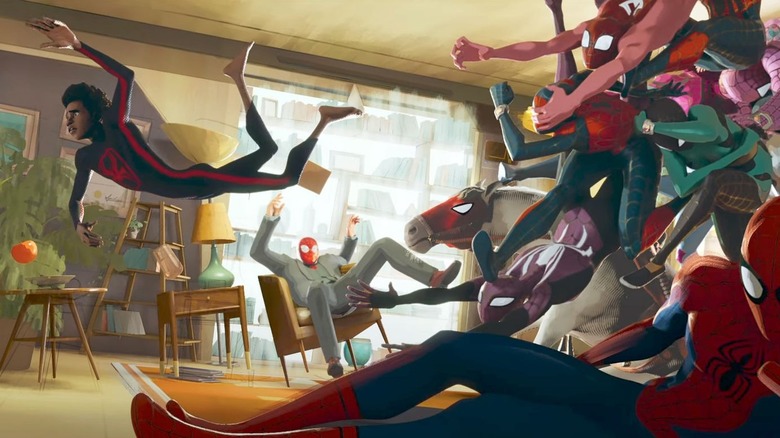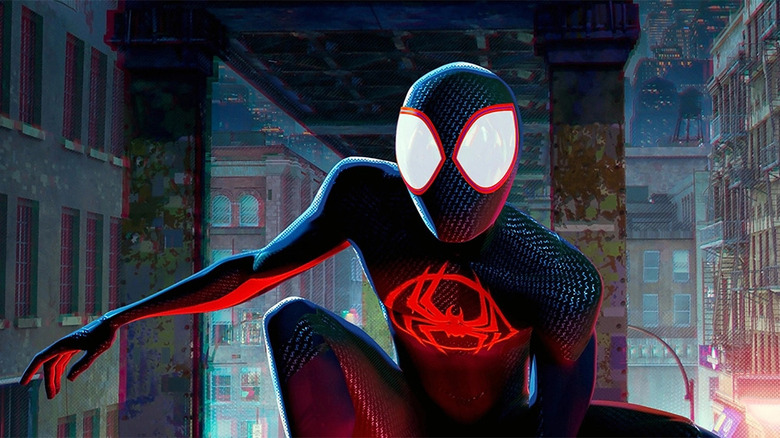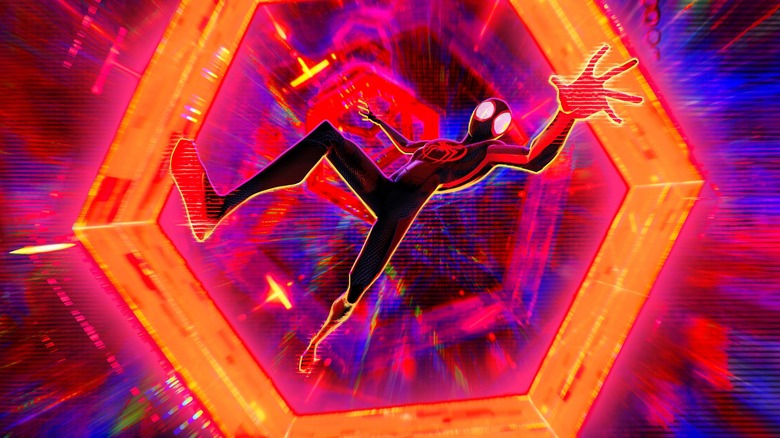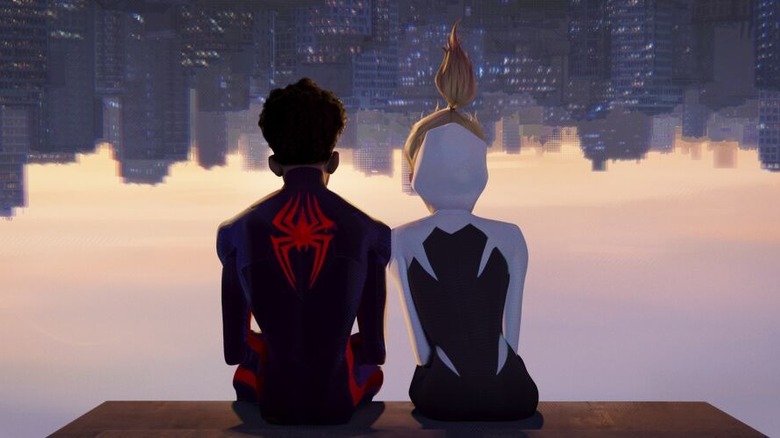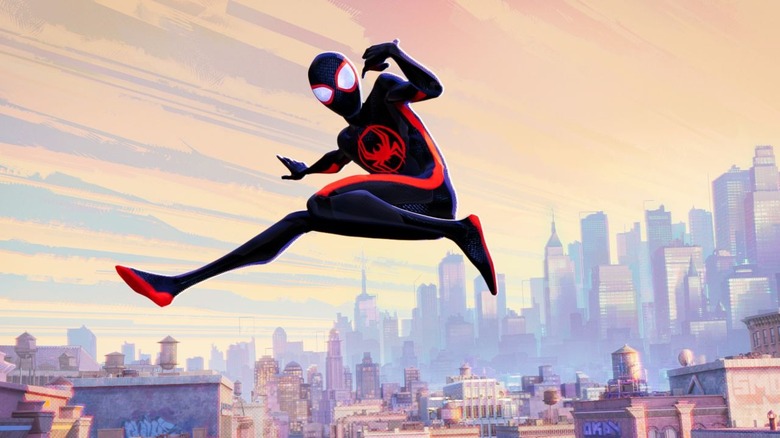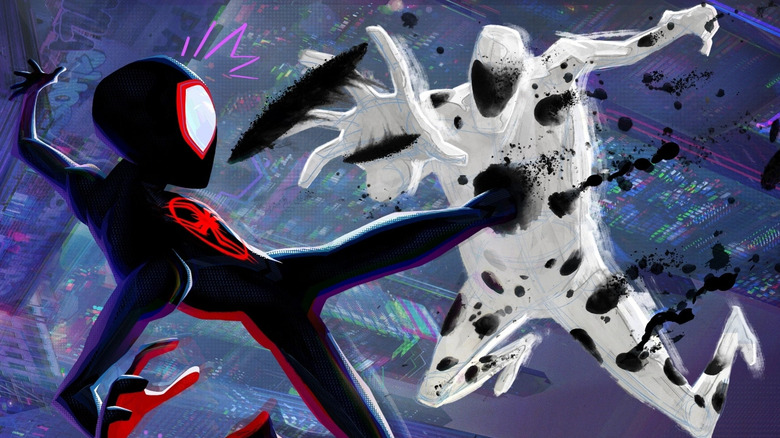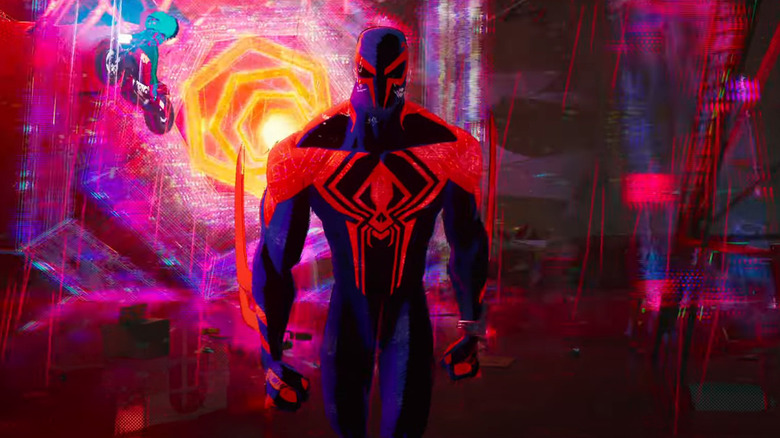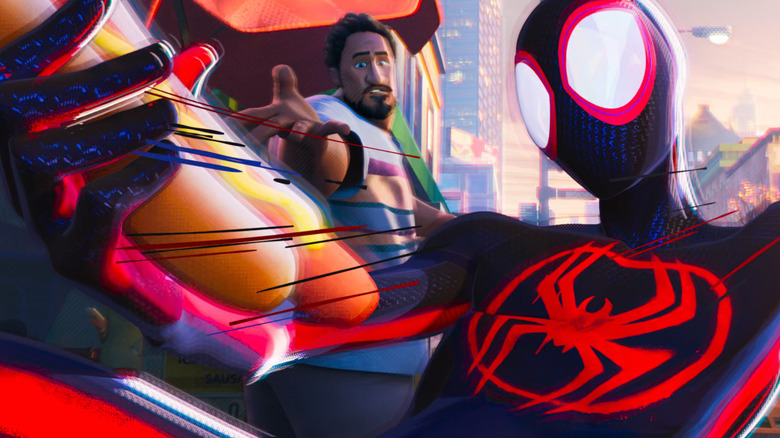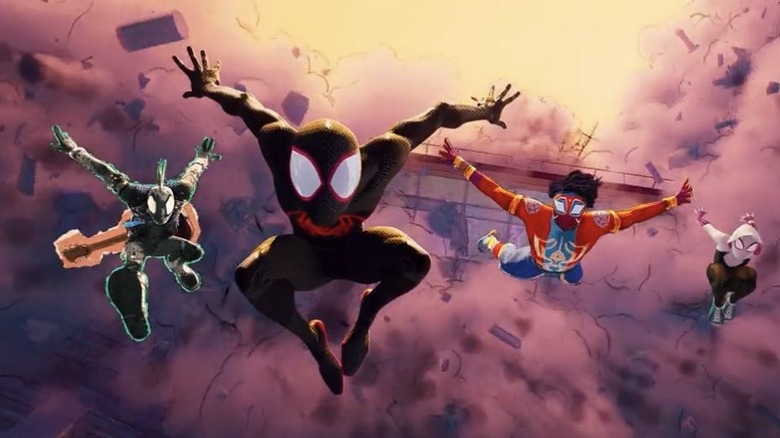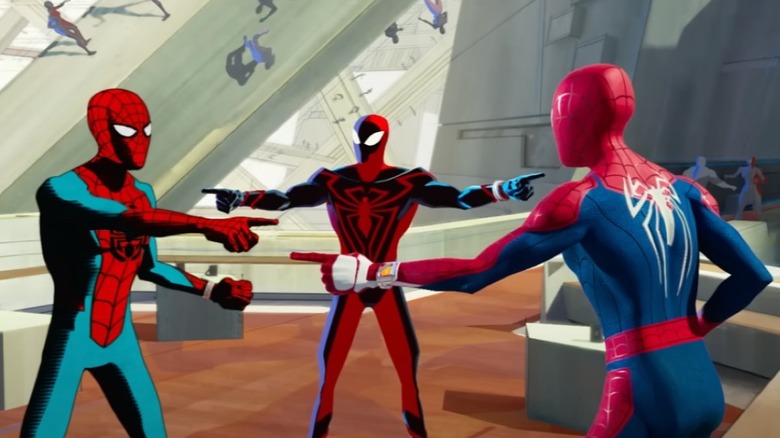Why Spider-Man: Across The Spider-Verse Blew Everyone Away At The Box Office
In 2018, "Spider-Man: Into the Spider-Verse" debuted to $35 million in ticket sales and went on to earn a total of $375 million globally. That was successful enough for Sony to warrant a sequel, but it didn't come close to the billion dollars, give or take, that many superhero movies make. The second of three installments, "Spider-Man: Across the Spider-Verse" (a third film, "Spider-Man: Beyond the Spider-Verse" is due out in March 2024), was predicted to do better than its predecessor. The film was tracking to take in about $80 million on opening weekend, which would have more than double the original's haul. Instead, the sequel web-slung far beyond everyone's expectations.
"Across the Spider-Verse" opened with the second best Thursday night preview of all time for an animated film at $17.35 million, just behind the $18.5 million that "Incredibles 2" managed in 2018. Its Friday night total of $51.7 million is the highest of any movie so far in 2023, and its $120.6 million domestic and more than $200 million international performance more than tripled the original. With opening numbers like that, "Across the Spider-Verse" could be on pace to match the near billion dollar sums that live-action comic book movies (with much larger budgets) sometimes achieve.
So, how did Sony and the production team (including writer-producers Phil Lord and Christopher Miller plus directors Joaquim Dos Santos, Kemp Powers, and Justin K. Thompson) pull off such a stunning box office feat? Read on to untangle the web.
The Spider-Verse has gained a following since 2018
Spider-Man might just be the most popular superhero character in the United States, so it sounds like a stretch to say that "Spider-Man: Into the Spider-Verse" suffered from a lack of audience familiarity. But the original film was largely an unknown quantity to prospective moviegoers, both in terms of its aesthetic and its main character. Compared to blockbuster live-action tentpoles starring the likes of Tom Holland or Andrew Garfield, this Spidey flick arrived somewhat under-the-radar.
The animation style — bold, frenetic, meant to look like a comic book come to life — was unlike what audiences had seen before. "Into the Spider-Verse" was centered around Miles Morales, not Peter Parker, making the character something of an unknown. While the African-American/Puerto Rican teenager was a draw for fans who already knew and loved the character, he was a stranger and possible point of confusion for more casual viewers.
As sometimes happens with a franchise (Austin Powers, The Matrix, Pitch Perfect), the original film would go on to win over legions of new fans in their living rooms, building a groundswell that had the sequel opening to a far larger potential audience. As a result, "Across the Spider-Verse" will likely surpass the box office total of its predecessor in mere weeks.
With a 2019 Oscar win for best animated feature and a plethora of other accolades, "Into the Spider-Verse" was too successful to be called a cult movie, but it nonetheless collected a substantial cult of die-hards, organically. As Slashfilm puts it, the sequel's success "speaks volumes about how the audience for the first film exploded over the last 4 years."
Keep in mind, this trend is likely to continue — "Across the Spider-Verse" will undoubtedly play well in living rooms for months to come, winning over new converts who will be pounding at the theater doors in March 2024 for "Spider-Man: Beyond the Spider-Verse" to see the resolution of various cliffhangers. Since the two films are companion pieces, it's hard to imagine anybody saw the second film who isn't also planning to see the third.
Spider-Man movies are safe bets
Of the 10 feature films made about Spidey before "Spider-Man: Across the Spider-Verse" (that have come out in the 21st century), "Spider-Man: Into the Spider-Verse" is an outlier. It's the only one to have made less than $700 million worldwide. Nonetheless, its $375 million-plus final number still represented a healthy profit when compared to its $90 million budget.
For over two decades now, Spider-Man movies have been as close to a sure bet as you can get in Hollywood, regardless of who stars in them or how well they're received by critics and audiences. Peter Parker's appearances in the Marvel Cinematic Universe have (not coincidentally) come in some of its most lucrative installments — "Captain America: Civil War," "Avengers: Infinity War" (in which he kind of steals the show), and "Avengers: Endgame" — which, combined, made about $6 billion.
Sony may not have expected this big a hit with its "Spider-Verse" sequel, but it was always going to do well enough in its opening weekend to justify its existence, simply because of fail-safe intellectual property. Every estimate had its premiere totals tracking well above the $35 million opening of "Into the Spider-Verse." For the creators of "Across the Spider-Verse," and fans who can't wait to see more, the sequel looks to have raised the take considerably.
Multiversal stories are more mainstream now
When "Into the Spider-Verse" premiered, moviegoers who weren't steeped in the source material may not have been exposed to (or even fully understood) the concept of a multiverse. While there were stray sci-fi movies and tv shows that dealt with alternate realities, the word "multiverse" was rarely if ever used, and the concept was hardly in the zeitgeist.
Although the notion was vaguely referenced in 2016's "Doctor Strange," the MCU's multiverse didn't really get kicking until 2019's "Avengers: Endgame." Into Phases 4 and 5, inter-dimensional stories like "Loki" and "Doctor Strange in the Multiverse of Madness" brought it heavily into the overarching plot. That means "Into the Spider-Verse" should get substantial credit for making multiverses mainstream. Consider this: Only four years after that film served as a multiverse primer, "Everything Everywhere All at Once" — a film about multiverses (and powerful bagels) — would win seven Academy Awards, including best picture.
In years between the first and second "Spider-Verse" films, the notion of infinite planes of existence has become commonplace enough that it almost feels like a cliche. Audiences probably didn't buy a ticket to "Spider-Man: Across the Spider-Verse" specifically because they love multiverses so much; it's the fan-favorite character and the phenomenal animation that are the stars of this series. But because multiversal storytelling has more of a place in popular culture than ever before, more people went into theaters this time feeling like they could hit the ground running.
Excellent reviews and word of mouth helped
While history shows that people will go see a "Spider-Man" movie regardless of the reviews, it certainly helps if the buzz prior to release is as strong as it was "Spider-Man: Across the Spider-Verse."
Following on the heels of opening weekend, its Rotten Tomatoes score sits at 95 percent, making it one of the most acclaimed major studio films of the year. Its audience score is even higher at 96 percent. Similarly, "Across the Spider-Verse" has an 87 (designating it a must-see) on Metacritic and an A CinemaScore (which indicates crowds were nearly universally pleased with what they saw) as well.
Though "Spider-Man: Into the Spider-Verse" has a slightly higher 97 percent Rotten Tomatoes rating, many critics called it even better than the original in their write-ups. The sequel has been praised as "a brilliant feat of artistry," "a stunning spectacle that also still manages to tell a smart, character-driven story," "a mind-breaking work of staggering genius," "an instant classic," "a multiversal masterpiece," and "a triumph on every level."
Fan sentiment has been equally effusive. Rotten Tomato users have called it, "AMAZING," "the best movie of 2023," and "the best animated film of all time." In fact, the only things bringing down those scores are the film's abrupt ending. It's two hours and 30 minutes, yet is effectively the first half of a story that will resolve itself in next year's "Spider-Man: Beyond the Spider-Verse."
It premiered in a sweet spot on the release calendar
The release of "Spider-Man: Across the Spider-Verse" was delayed, twice. Initially, a teaser advertised a premiere date of April 2022. That got bumped back to October, then Sony execs finally settled on June 2, 2023. Though the postponements were frustrating to fans eager to see Miles Morales in action again, this might be a case of good things coming to those who wait, both for the creators of the film and for audiences. The move gave the team more time to get "Across the Spider-Verse" just right, and it provided the movie with a choice spot on the calendar.
With school letting out and families looking for something to do, "Across the Spider-Verse" only had "The Little Mermaid" (in its second week) to grapple with at what feels like the start of the summer blockbuster season. "The Super Mario Bros. Movie" and "Guardians of the Galaxy Vol. 3" are still in theaters, but they aren't the juggernauts they were five and nine weeks prior. Coming later in June are "The Flash" and Pixar's "Elemental," both of which drop into cinemas on the 16th. The former has strong buzz but a potential problem to overcome in its embattled star, Ezra Miller. Bad reviews out of Cannes poured cold water on the latter. Neither is tracking anywhere near the "Spider-Verse" sequel's opening weekend totals, all of which should allow the Spidey sequel additional weeks to dominate the box office and pad its totals.
It's PG enough for kids
While the vast majority of animated movies are rated PG, the vast majority of superhero and comic book movies are rated PG-13. That PG-13 rating, however, doesn't necessarily stop parents from bringing younger children to see, say, the latest installment of the MCU.
Sometimes word gets out that a PG-13 film, even about a main character in a superhero costume, is too much for some kids to handle. Such conversations occurred around "Doctor Strange in the Multiverse of Madness" and "Guardians of the Galaxy Vol. 3," directed by Sam Raimi and James Gunn, both with considerable reputations for adult fare, known to push the envelope when it comes to horror, adult situations and humor.
Like the original, "Spider-Man: Across the Spider-Verse" is rated PG, but brilliantly positions itself in the grey area between eye-dazzling kids cartoon and adult-pleasing dark superhero territory. This gives parents of children who might still be too young for some of Marvel's racier titles peace of mind. Sure, the artistry and the emotionality are far more mature than the average animated movie — but the film's villain, The Spot, is a hoot. He's funnier than he is scary.
There's also minimal objectionable language, no gross out moments, no blood. "Across the Spider-Verse" is packed full of good role models and positive messages about what it means to be a kid and a parent. Its well-deserved PG rating, plus its overall quality and relevant themes, make it perfect for a family outing.
But still edgy enough for teens and adults
Just because "Spider-Man: Across the Spider-Verse" is appropriate for single digit-aged audience members doesn't mean older teens and adults won't be entertained. Yes, it's a cartoon. Yes, it has messages about family and identity. But absolutely nothing about "Across the Spider-Verse" is simple or sugar-coated.
Visually and narratively, the film is equal parts authentic and edgy. Miles and Gwen face complex and sometimes gut-wrenching problems that don't have obvious solutions. Whole stretches of the movie are downright sad, which is skillfully reflected in the animation style and color palette. And in a meta bit of commentary about "Spider-Man" as a franchise, "Across the Spider-Verse" deals with the inevitability of loss, especially in its second half.
The humor is also sharper than one would expect from a PG movie. Lord and Miller are known for being able to deliver rapid-fire gags, as they did in "The LEGO Movie" (another PG rated film that manages to be PG-13 style funny), which gets a particularly effective homage (made by a 14-year-old!) in "Across the Spider-Verse." The jokes are smart, subversive, and fun, and the plot, which is remarkably unpredictable for a kids movie, keeps fans on their toes and trying to guess what's going to happen next.
The film's PG rating welcomes a younger subset of viewers, while doing nothing to deter the demographic that usually prefers more complex PG-13 and R-rated movies.
Promotional tie-ins got fans' attention
Kid movies and superhero movies go together with merchandising opportunities and product placement like ketchup and mustard on a hot dog; every time one comes out, brand new affiliated items can be found on store shelves and at fast food restaurants. "Spider-Man: Across the Spider-Verse" is no different.
Tied to its release, Burger King offered a limited time BK-Verse menu that featured a red-bunned Whopper and a Spider-Verse ice cream sundae. The Whopper sold out within days. Selling out even faster were new "Across the Spider-Verse" X Air Jordan 1 "Next Chapter" high tops, gone in less than an hour. The highly sought-after shoes, already marked up on sites like GOAT and StockX for those who missed out, are featured in the film.
Merch builds hype among the most devoted fans and collectors, but not everyone cares about these kinds of promotions. Just because Burger King, LEGO, and Nike (and Spider-Man, for that matter) are household name brands, that doesn't mean everyone is desperate for a red hamburger bun or a pair of $200 sneakers that only slightly differ from the ones sold five years ago. These types of promotions do, however, get a film's name out there. Logos and images are plastered on store windows and internet browsers, and people subconsciously become aware that a movie like "Across the Spider-Verse" is coming soon.
Its cool factor is off the charts
For all the planning and expertise that goes into making and marketing a movie, there's something intrinsically intangible, something over which creators have little control. Is it cool?
If a piece of pop culture becomes cool to engage with, talk about, make memes about, etc., its vapor trail across the cultural conversation landscape is far longer; as it builds an audience, no one wants to be left out. "Spider-Man: Across the Spider-Verse" is undeniably cool.
But this impossibly high cool factor didn't come out of nowhere. Miles' Jordans and Gwen's Converse are well-established, eternally cool brands. The creative flourishes and in-jokes are cool. Lord and Miller — patron saints of "how are they going to make that a movie" movies based on LEGOs and "21 Jump Street" — are cool. The voice actors — Shamiek Moore, Hailee Steinfeld, Oscar Isaac, Issa Rae, Jake Johnson, Brian Tyree Henry, and Andy Samberg — all ranfe from well known to beloved. The original soundtrack by Metro Boomin and a Spider-Verse-full of famous collaborators is cool, as well.
But perhaps the coolest thing about "Across the Spider-Verse" is a new, surefire breakout fan favorite character, Spider-Punk. Otherwise known as Hobie Brown (a Prowler from another Spidey universe), Spider-Punk is depicted in a faded out two dimensional collage of poster scraps, reminiscent of the Sex Pistols aesthetic, among others. Played by Oscar winner Daniel Kaluuya, he has a thick cockney accent, and when he takes his mask off, Miles can't believe he's even cooler underneath. It's no surprise that the terms "Hobie" and "Spider-Punk" were trending on Twitter upon the film's release, or that fan art is already proliferating across the internet.
It begs to be seen multiple times
Most people who saw "Spider-Man: Across the Spider-Verse" on opening weekend only saw it once, but you can bet many will be seeing it again; some even bought another ticket shortly after walking out of the theater. This is one sequel that begs to be rewatched, for multiple reasons.
First, the art, the music, the script, and the voice acting are so layered and complex, fans want to pull further on some of the many threads that appear briefly (was that Peter Parker... as a car?). Second, though there are moments where the movie slows down to have a moment of human connection (like when Miles and Gwen hang upside-down from a rooftop ledge), most of it moves so fast, audiences leave a first viewing feeling as though they must have missed something.
The sequel is overflowing with Easter eggs, callbacks, and cameos; sometimes multiple references share the same frame. There are allusions to the first movie, allusions to the live-action "Spider-Man" movies, allusions to Lord and Miller's other movies, nods to comic books, nods to video games, as-of-yet unseen variants of Spider-Man, and the number 42 appears more times than anyone could reasonably catch the first time around. There are even editor notes, like in the comics, which sometimes appear and vanish too quickly for viewers who don't yet have the benefit of a pause button.
Taken as a whole, this ridiculous level of re-watchability should help "Spider-Man: Across the Spider-Verse" stay at or near the top of the box office throughout the first half of the summer.
